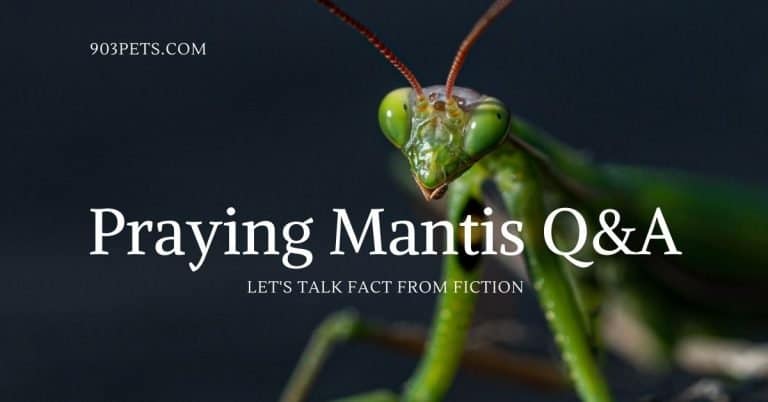Ultimate Beginner’s Guide to Praying Mantis Pet Care
Making the decision to have a pet is kind of a big deal. It requires consideration of your life stage and lifestyle, budget, climate and space available in order to find the right pet for your circumstances and your personality.
For some people, an insect pet is an ideal companion. Not many insect pets are more fascinating than the praying mantis.
In this beginner’s guide to praying mantis pet care, we’ll guide you through the process from buying a praying mantis to selecting and creating an enclosure, along with feeding and caring for them.
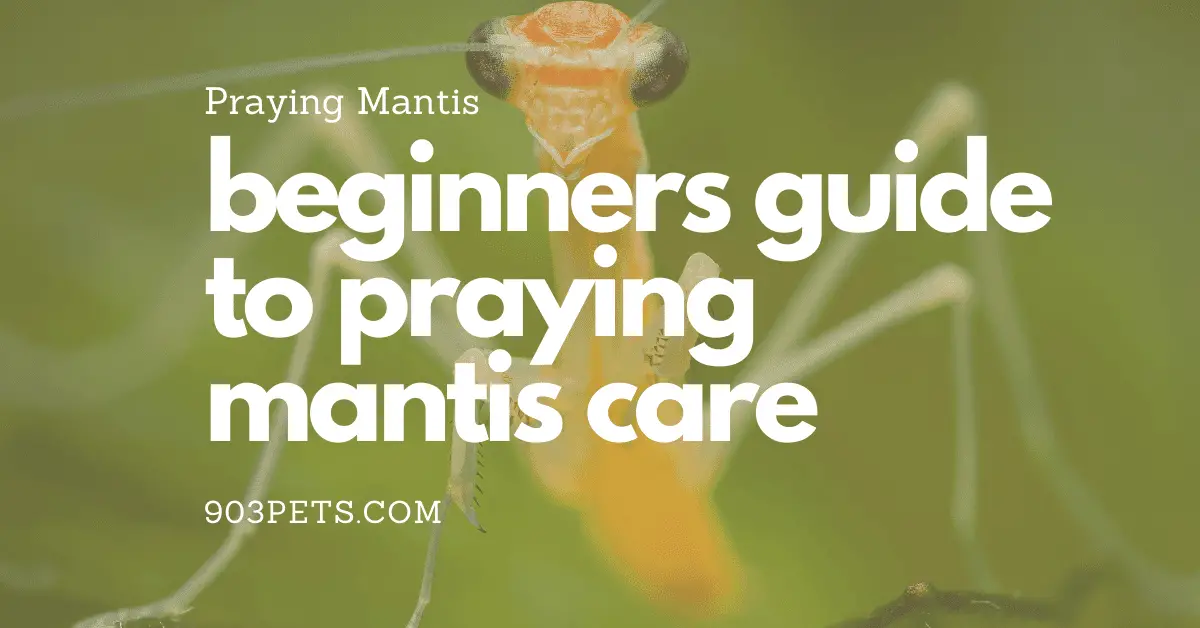
Let’s get into it!
Before you purchase a praying mantis you should know
Are praying mantises good pets? Yes, they can be for the right person. But, before you get started, there are a couple of things we want to be sure you understand about keeping a praying mantis as a pet.
Praying mantises live about one year. So if you will find it hard to get through the certain death of your praying mantis around its first birthday, perhaps a longer living pet is better for you.
When it comes to feeding a praying mantis, you’ll be feeding it live creatures. If you don’t have a stomach for that, think about a different insect pet. Maybe one of these easy beginner pets is best for you.
Are praying mantises dangerous? Not particularly to its owner but there are some other things you’ll want to know before buying your first mantis.
Do you want to hatch eggs or buy a live praying mantis?
When it is time to acquire your pet praying mantis, there are two options; a live praying mantis or praying mantis eggs.
Live praying mantis
Choosing to purchase live praying mantises is a common approach for classroom pet projects and people like you who are looking to raise a pet.
In the warmer seasons in certain locations, you might be able to find a wild praying mantis to capture. For year-round availability, live paying mantids can be purchased from reputable dealers.
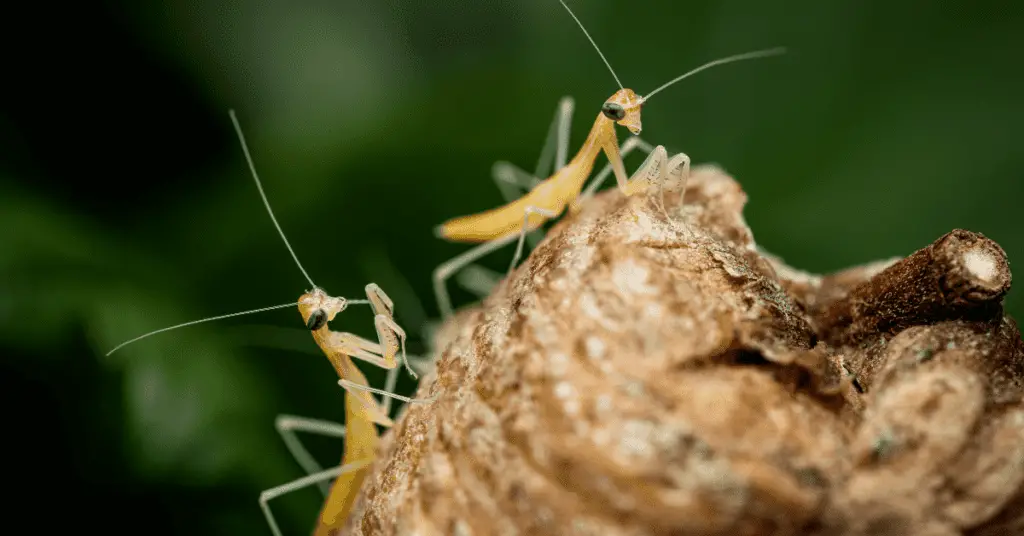
Praying Mantis Eggs, Cases, and Ootheca
Praying mantis eggs, called an ootheca, can be found outdoors in some areas or purchased online from a retailer who specializes in mantids.
The exact number of eggs in an ootheca will vary. Common praying mantis species will have oothecas containing 50-200 eggs.
That means you will be raising a bunch of mantids at once if you want to go this route. With native species, some individuals suggest keeping the number that you want to raise and releasing the remainder into the wild.
Obviously, not all the eggs will hatch and not all the mantids will live to adulthood, but you’ll still have plenty to raise.
Where can I find a live praying mantis pet?
Like most pets, there are two ways to obtain them. You can either purchase a praying mantis or catch one in the wild.
Let’s look at where you can find them not matter if you want to catch one or buy a praying mantis for a pet.
Catching a live praying mantis
Praying mantises are found in most areas of the U.S. They are typically found in the Eastern United States, but have been identified as far west as California. Only 11 species of are native to North America while the Northeastern U.S. is home to European and Chinese mantids as well.
They are green and brown insects that typically feed on other insects. Praying mantises can be hard to find in the wild because they like to hide and are great at camouflage.
The best places to look for praying mantises are either on tree limbs, stalks, and leaves of plants or trunks of trees. Because they are mostly brown or green, look for them on plants and trees that are brown or green.
That means they really do blend into your landscape, making them quite hard to find.
Female mantises prefer to lay their eggs in the dense branches and leaves of shrubs. Flowers can also be an attractant since they bring in more insects for the mantids to prey upon. Flowers such as cosmos, marigolds, and even dill are good options.
When trying to catch a praying mantis, you may not need anything other than a twig or your hand.
Move slowly and place your hand or twig in front of the mantid so that it can choose to climb onto it. Have your enclosure ready and simply move with the mantid to place it into the enclosure.
Again, slow and steady is the name of the game.
Of course, some mantids can fly so if you want to use an insect net like this one, your chances of catching the mantid will increase.
Buying a live praying mantis
Many of us rarely see wild mantids. So, getting a praying mantis as a pet will see success by purchasing a live mantis from a breeder.
The key is to find a reputable breeder that will ship live mantises. Most sources are happy to sell egg cases, ootheca, but fewer will sell and ship live praying mantises.
Keep in mind that reputable outlets will not ship live praying mantises unless there is a high likelihood that the mantid will arrive alive.
This means that most retailers will stop selling live mantids in the winter and heat of summer since the outside temperatures in geographies will kill a praying mantis. Generally, sellers will not ship live praying mantises if the outdoor temperatures at the destination or origination location are above 89F or below 40F.
Additional, most retailers will ship live mantids only on Monday and Tuesday so as to ensure the live mantids are not stuck over a weekend before delivery.
Here are 3 tips to ensure the best experience when buying live praying mantises:
- Order from a reputable dealer – Good retailers will have guidelines around outdoor temperatures, delivery expediency, delivery dates, include heat or cold packs as needed, and have a guarantee. That guarantee will be null and void if you don’t live up to your end of the bargain. Some guarantees cover only if a certain percentage of the live insects are dead on delivery and must be reported with a couple of hours of delivery. Some reputable retailers may ship 2 praying mantises for every 1 ordered to cover any potential losses during shipping.
- Be at the delivery location and available on the delivery date – A mantid can arrive alive in the morning but if left sitting on the porch in the sun all afternoon before you get home, may end up toasted and dead. It is your responsibility to receive the delivery and immediately remove the mantid and place it in a proper enclosure with good humidity and a misting of water. They’ll be thirsty and hungry.
- Live animal shipping is expensive – You’re going to pay a hefty price for USPS Priority Express Shipping or UPS AIR shipping. This ensures the package with your live mantis get’s to your doorstep as quickly as possible. Some retailers include whatever shipping materials are needed to ship your mantids. Others, require you to add the containers, heat or cold packs, food, and pick the right shipping option. Just be aware that shipping alone could be $37.95 or more.
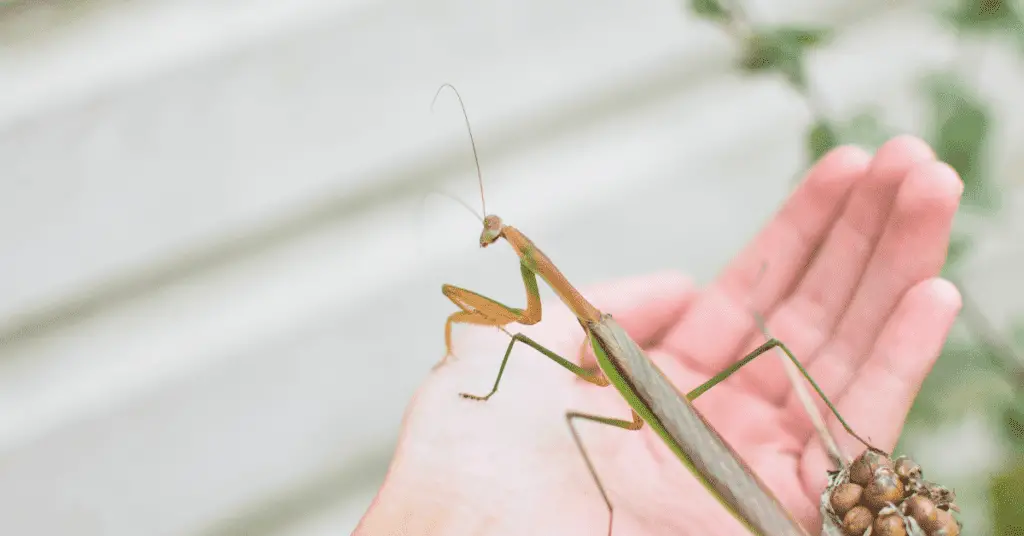
Praying Mantis Pet Care Tips
When it comes time to care for your pet praying mantises, it is important to know how to care for them optimally.
Common North America praying mantises can be easy to take care of with preparation and an observant eye.
- Enclosure size matters. Too big and they won’t find their prey to eat. Too small and they won’t have the room they need to molt and hunt.
- Humidity levels are important. Too low or too high a humidity will make it difficult for a praying mantis to molt. Molting incorrectly and lead to loss of limbs and even death of a mantis. Don’t go overboard, humidity is not an exact thing but a general range of environmental control that’s key.
- Temperatures are more than feel good. Did you know that if the temperature of the environment is too high it increases the metabolism of the mantis and can shorten its life? Too cold and it will not grow fast enough and can die from starvation due to a lack of hunting.
- Mist with water daily. We’re not talking a soaking misting but one or two sprays. A light misting is what you are looking for unless you are trying to get your humidity level back up. Mantises will drink the water droplets.
- Feed praying mantises at the appropriate rate. Mantises are voracious eaters and should be fed daily when they are young, except when they are molting. During the molting process, mantises will stop eating. Older mantises, L4 and above, may only eat once every 3-4 days. Overfeeding can reduce their lifespan, just as underfeeding can.
Below we cover a number of topics in more detail.
What’s the best praying mantis habitat for a pet?
Housing your pet mantises is crucial since this is the world they will live in for the remainder of their lives.
Enclosures should be clear so that you can observe your mantids and it must be big enough to allow plenty of room to climb and hang during molting.
The characteristics to look for in an enclosure, whether you are buying one or construction one, include:
- 4+ times taller than your mantis will be long. I.e. Taller than it is wide.
- 3+ times wider than you mantis will be long
- Clear sides to viewing your lovely mantis
- Openings with mesh for ventilation
- Easy off/on lid. Makes daily misting easier.
- Wide enough opening to easily place you hand in all the way to the bottom. Periodically you will need to clean the enclosure.
- Able to be kept out of direct sunlight.
Some of our favorite enclosures are aquariums with mesh tops. Just be sure the mesh is small enough to not allow mantid nymphs to escape. More on that in a minute.
Another common enclosure is a large bell jar, however we recommend using plastic so that more ventilation holes can be drilled.
Let’s talk about a few more details.
How big of an enclosure does a pet praying mantis need?
Praying mantis pet enclosures must be taller than they are wide. How tall and how wide depends on the adult size of your praying mantis species.
Yes, you can keep nymphs is a smaller container and change containers as they grow, but we like to place ours in their adult homes when we separate the nymphs. That way they are growing up in their adult environment and we are frequently changing out homes.
We calculate the minimum enclosure size by taking the length of the adult mantis (L). The enclosure should be 4 times the adult mantis length (4L). The width of the enclosure should be 3 times the adult mantis length (3L). Other sources will use 3 and 2 for the numbers. That’s too small for our tastes.
Let’s take an example:
Carolina Mantis (Example)
Typical adult Carolina mantis females are 2-2.5 inches (47 to 60 millimeters) in length. Adult males are usually about 2.2 inches (54 millimeters) in length. For our calculations, let’s use the larger female dimensions.
2.5 inches * 4 = 10 inches 2.5 inches * 3 = 7.5 inches Carolina Mantis enclosure size = 7.5" X 7.5" X 10"
Therefore, a minimum Carolina praying mantis enclosure should be 10 inches tall and 7.5 inches wide. A 1-foot square enclosure would be great if you want to go above the minimum.
You’ll want to resist the urge to create a giant enclosure. Doing so will mean your mantis may have a difficult time finding the food you place in it. It also doesn’t mean you want to keep many mantids living together. They are known to be cannibalistic so the rule is one praying mantis to each enclosure.

Praying mantis ideal environment conditions
Once you have the enclosure, maintaining the environment in it is super important to ensure a good life for your pet mantis.
The first rule is to never place the enclosure in direct sunlight. Doing so will likely bake your mantis, not keep them warm. Sure, they are in sunlight in the wild, but they have the ability to hide from it when needed and it’s environment is not self-contained like that in an enclosure.
When it comes to praying mantis husbandry, temperature is arguably the most important, other than food.
The ideal temperature for mantids varies by species but generally, a temperature between 70F and 86F will work well. So, your natural indoor temperature will typically be just fine without additional heating or cooling.
Humidity is another key to praying mantis pet care. Higher humidity levels are good for mantises. Another general rule is to seek a humidity level of approximately 60%-70%. This is fairly easy to achieve with the required daily light misting with water.
Finally, you natural day/night cycle should be fine for your mantids. We do not recommend keeping a light on all day and night and deprive them of recognizing a daily cycle of light and dark.
How do I set up a praying mantis enclosure?
An enclosure is still not ready for your mantis until you set it up with a few necessary decorations. These include elevations, substrate, and ground litter.
Substrate
First, you need substrate for the bottom of the enclosure. Ideally the substrate should help retain some moisture without being muddy or growing mold.
A substrate recipe that you can tweak is:
- 1 part vermiculite
- 2 parts sand
- 3 parts top soil
Adjust as necessary the recipe above. The sand helps with some drainage while the vermiculite holds moisture.
Fill the bottom of the enclosure with this soil substrate to a depth of 1-2 inches.
Some people will add sphagnum moss to the top of the substrate as another natural moisture retention device.
Elevations
Praying mantises are natural climbers. They do this not only to find prey insects to feed on, but also for the purposes of molting multiple times until adulthood.
So, your enclosure (tank) needs things to climb on and a variety of elevations. Even the mesh top will provide a great place to latch onto for molting.
Some twigs should be placed in the tank so that the praying mantis can hang from them when they are undergoing molting. You can also use live or artificial plants, but don’t make the enclosure too crowded.
If using live plants, tall succulents like Eve’s Needle or Zebra Plant are great choices. Pothos is another popular option.
Do they sell praying mantis pet kits?
For beginners, it might be appealing to start with a kit that includes everything you need to get started.
Yes, some retailers do sell praying mantis starter kits. If you don’t want to hassle with finding and building everything yourself initially, these kits can be helpful but are certainly not necessary.
What should a praying mantis starter kit include? All praying mantis starter and classroom kits should include the following:
- (1) An enclosure with a mesh lid. (mesh popup enclosure or other)
- (1) Food source to last at least 2 weeks. (eg.
Flightless fruit fly culture) - (1) Water mister
- (1) Praying mantis egg case (ootheca) or live praying mantis juvenile
For small mantises this Zoo Med Creatures Creature Habitat Kit might do the trick.
What size screen mesh works best for praying mantis nymphs?
When talking a screen gauges, there are two worlds we can take from, insect screens for porches and screen printing, as in t-shirts.
When shopping for screen mesh to cover a praying mantis enclosure gauges are represented by two numbers. The number of threads per inch vertically and horizontally.
For insect screens, we recommend a minimum of 20×20 gauge. This should keep your nymphs well contained.
If art supplies are easier to come by, look at the screen printing supplies. These screens are represented by a single number that is the number of threads per inch which is the same both horizontally and vertically.
For screen printing mesh, we recommend a minimum of a 20 gauge to keep your small praying mantis nymphs and fruit flies in the enclosure without easily escaping.
What do you feed a praying mantis?
Praying mantises feed on live insect prey, even when they are newly hatched L1 nymphs.
The rule of thumb is that the prey insect should never exceed 1/3 the length of the mantis in size.
So, for young praying mantis nymphs, flightless fruit flies (Wingless Melanogaster) are a delicious and healthy meal for these voracious eaters. After the mantises are about a week old, upgrade to the Flightless D. Hydei fruit flies that are about 1/16th of an inch in size.
As mantises molt and get larger, feeding them blue bottle flies or other “houseflies” becomes possible. You can even buy cultures to grow them.
You can even grow feeder insects like fruit fly yourself and make your own culture to grow them in. We’ve got a few fly culture recipes to do it.
Larger adult mantises might eat wax or meal worms, crickets and other such critters. And yes, you can grow them too with enough time and space.
Finally, praying mantises require water. They drink water as droplets from vegetation. That daily or every other day water misting provides that necessary source of H2O.
For some species a piece of sponge daily soaked in water may provide a good source of water to drink from without creating a drowning pool of water.
How often do you feed praying mantises?
We’ve said before that praying mantis nymphs (babies) are voracious eaters.
The frequency of feeding a praying mantis starts with daily feeding of L1-L4 nymphs. Mantises that are L5-L7 can be fed every other day. L8 – Adult praying mantises can eat every 2 or 3 days. These are general guidelines and the size of the mantises abdomen will give you a sense of when it is time to feed again. narrow abdomen, it’s time to feed. Swollen abdomen means they can wait a bit before eating again.
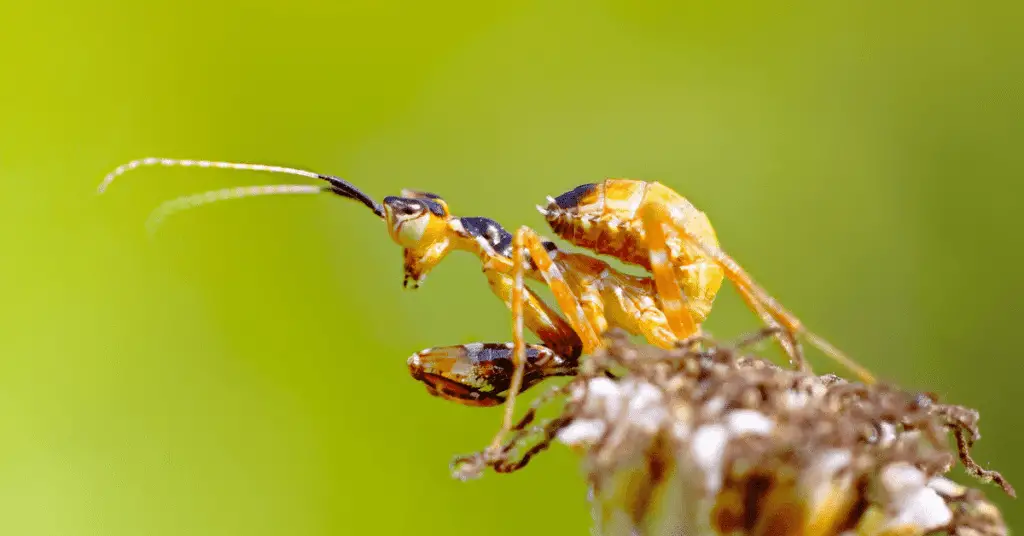
Do praying mantis eat fruit or vegetables?
No, praying mantises do not eat fruits and vegetables. Instead, they eat the insects that do eat fruits and vegetables.
So, if you place fruit or vegetables in the mantis enclosure, your doing so only to grow other insects, not to directly feed the mantids. But be sure to remove them before they grow mold.
Can I buy praying mantis pet food?
Yes, you can purchase cultures of different types of flies to grow as food for your praying mantises. Wax worms and meal worms can easily be purchased as another potential meal option.
When purchasing fly cultures, you will receive fly pupae that will be ready to begin hatching in just a matter of days from receiving them.
On average, 500 blue bottle fly pupae will cost about $14-15 while flightless fruit fly cultures will cost $12-$14. Depending on the supplier, shipping costs will vary.
As the flies mature, you will add them to your praying mantis enclosure. The praying mantis will know exactly what to do next. Eat!
Where can I buy live insects for a praying mantis to eat?
Most retailers who sell live praying mantises also sell praying mantis food options.
Some common retailers who sell praying mantis food insects include:
How To Clean A Praying Mantis Enclosure?
Praying mantis containers should be cleaned weekly for small insect cups and bi-weekly to monthly for larger enclosures. Only use hot water to clean the environment, never soaps or harsh chemicals. Clean when you notice any mold or fungus growing, especially in the substrate.
A praying mantis enclosure will need to be cleaned on occasion.
Larger enclosures will be cleaned less frequently than smaller enclosures. Small insect cups may need to be cleaned weekly while a 12″ cube might only need to be cleaned monthly.
They key to knowing when to clean the praying mantis home is to look for fungus or mold starting to grow or foul scents coming from the setup.
The steps to clean a praying mantis enclosure are:
- Remove the mantis from the enclosure
- Remove all branches, plants or other accessories
- Remove and throw away the substrate
- Using a paper towel wipe all surfaces
- Rinse with hot water
- Repeat steps 4-5 two or three times
- Add new substrate and lightly moisten
- Add accessories back
- Reintroduce the mantis to the enclosure
Trick To Prevent Mold or Fungus In Substrate
If you are using Eco Earth or other organic substrates, there is a trick that will increase the time between substrates changes. While this trick is not reserved for praying mantis homes, we can borrow from our reptile friends just the same.
The trick is to release springtails into the substrate. You can purchase springtails from many pet shops or reptile specialty stores including online outlets.
Springtails are very tiny (<6mm or .24 inches) critters that love to eat, therefore breaking down organic materials. This includes fungus and molds.
Go Care For That Pet Praying Mantis
Now that you know all the basics, it’s time to dive in and get that first praying mantis pet.
To make it easy, we put together a praying mantis care kit list below to get you started with links for every item.
We’ve used Amazon products as much as possible to keep it simple.
DIY Praying Mantis Starter Kit
- (1) Praying mantis
- Praying mantis live ootheca (egg case) OR
- Live Praying mantis (Carolina – native U.S. species)
- (1) Enclosure
- (1) Water mister
- (1) Flightless fruit fly culture OR on Amazon – Josh’s Frogs Wingless Drosophila Melanogaster Fruit Fly Cultures
- (1) Temperature/Humidity monitor
- (1) Creature Soil OR Topsoil
- (1) Spaghnum moss (instead of vermiculite and sand)
- (1) Planter for plants
- (1) Zebra plant
- (2) Twigs/Branches (Free! Go outside and get some)
That’s it! Give it a go and see what fun having a praying mantis as a pet can be. Just follow our guide above to start your journey to praying mantis pet care and watch them grow from tiny nymphs to adults in a matter of months.
If you think your pet is ill, call a vet immediately. All health-related questions should be referred to your veterinarian. They can examine your pet, understand its health history, and make well informed recommendations for your pet.
903pets.com Staff


![Beginners Guide to Pet Snail Care [Simple] 6 Beginners Guide to Pet Snail Care [Simple]](https://cdn-0.903pets.com/ifywhoft/2021/09/ultimate-guide-to-pet-snail-care-for-beginners-768x402.jpg)
![Praying Mantis Egg Cases - Buyers Guide [Info & Tips] 8 Praying Mantis Egg Cases – Buyers Guide [Info & Tips]](https://cdn-0.903pets.com/ifywhoft/2022/05/praying-mantis-egg-cases-buyers-guide-768x402.jpg)



